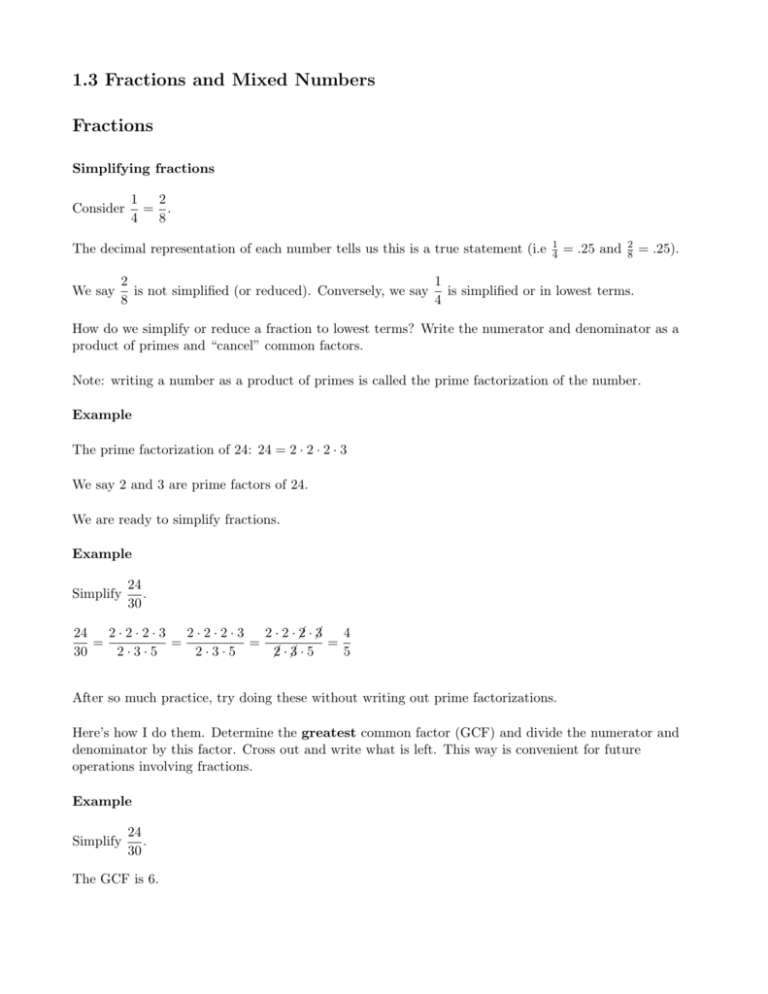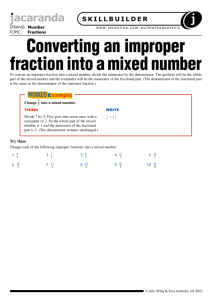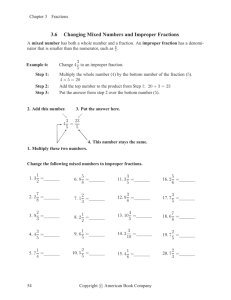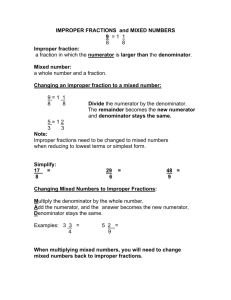1.3 Fractions and Mixed Numbers Fractions
advertisement

1.3 Fractions and Mixed Numbers Fractions Simplifying fractions Consider 1 2 = . 4 8 The decimal representation of each number tells us this is a true statement (i.e We say 1 4 = .25 and 2 8 = .25). 2 1 is not simplified (or reduced). Conversely, we say is simplified or in lowest terms. 8 4 How do we simplify or reduce a fraction to lowest terms? Write the numerator and denominator as a product of primes and “cancel” common factors. Note: writing a number as a product of primes is called the prime factorization of the number. Example The prime factorization of 24: 24 = 2 · 2 · 2 · 3 We say 2 and 3 are prime factors of 24. We are ready to simplify fractions. Example Simplify 24 . 30 24 2·2·2·3 2·2·2·3 2 · 2 · 2 · 3 4 = = = = 30 2·3·5 2·3·5 2 · 3 · 5 5 After so much practice, try doing these without writing out prime factorizations. Here’s how I do them. Determine the greatest common factor (GCF) and divide the numerator and denominator by this factor. Cross out and write what is left. This way is convenient for future operations involving fractions. Example Simplify 24 . 30 The GCF is 6. 4 24 4 = 5 30 5 Performing Operations with Fractions Here are the rules and some examples. Multiplication Rule: a c ac · = b d bd Saying: across the top, across the bottom. Example 1·3 3 1 3 · = = 2 4 2·4 8 Suggestion: if possible, simplify before you multiply. Example 2 1 4 1 4 1·2 2 · = · = = 2 5 2 5 1·5 5 1 Division a c a d Rule: ÷ = · b d b c or a a d b c = b·c d Saying: multiply by the reciprocal. Example 1 2 1 3 1·3 3 ÷ = · = = 2 3 2 2 2·2 4 Again, if possible, simplify before you multiply. Addition/Subtraction Rule: a b a±b ± = d d d Saying: find a common denominator and across the top. Note: always check if you can simplify after addition or subtraction. Example: with common denominator 3 1 3+1 4 + = = 5 5 5 5 Example: without common denominator 3 1 6 1 6−1 5 1 − = − = = = 5 10 10 10 10 10 2 We call 10 the least common denominator (LCD); in other words, the least common multiple of the denominator. Mixed Numbers So far, most of the fractions we have considered have a numerator less than the denominator, e.g. 2 . 3 Considering positive fractions only, the above statement implies 0 < fraction < 1. When the numerator is greater than the denominator (so fraction > 1), then it is an improper 3 fraction, e.g. . 2 An improper fraction can be written as a mixed number. A mixed number has a whole part and a fractional part. Example 3 1 =1 2 2 When performing operations with mixed numbers rewrite as improper fractions. With addition/subtraction, you could work with either, but I think you will find improper fractions “easier.” Example: working with improper fractions 5 1 17 13 73 2 +3 = + = 6 4 6 4 12 Example: working with mixed numbers 5 1 2 +3 6 4 Add whole parts: 2 + 3 = 5 Add fractional parts: 5 1 13 + = 6 4 12 We would not write 5 Instead, 13 13 since is improper. 12 12 13 1 1 1 =1 and so we have 5 + 1 = 6 . 12 12 12 12





